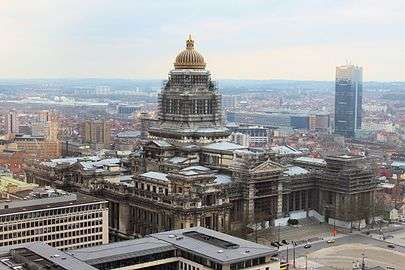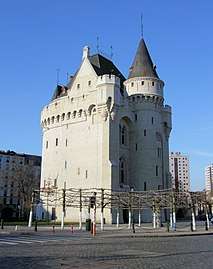Marollen
The Marolles (French, French pronunciation: [maˈʁɔl]) or Marollen (Dutch, Dutch pronunciation: [maˈrɔlə(n)]) is a popular historic neighbourhood of Brussels, situated between the Palace of Justice and Brussels-South railway station.[1] Lying at the heart of Marolles are the Chapel Church and the Place du Jeu de Balle/Vossenplein. Major arteries of the district include Rue Haute/Hoogstraat, Rue Blaes/Blaesstraat and Rue des Tanneurs/Huidevetterstraat. Its inhabitants are called Marolliens. The dialect known as Marols (marollien) was spoken in this area until the 20th century.
_(14773620895).jpg)
History
Development
The area now occupied by the Marolles lay, during the Middle Ages, in the first circumvallation of the city of Brussels. Lepers were exiled to this area, and they were cared for by the Apostoline sisters, a religious group from which the toponym Marolles is thought to be derived (from Mariam Colentes in Latin ("those who honour the Virgin Mary"), later distorted into Maricolles/Marikollen). The sisters presence was short-lived, as they relocated to the Quai au Foin/Hooikaai in the Quays District. The first mention of a Walsche Plaetse (1328) probably indicates an early presence of French-speaking traders and craftsmen in the neighbourhood, as it was a logical arrival place for migrants from the south.[2] In 1405, a fire broke out in the neighbourhood and destroyed some 2,400 homes.[3] In the 17th and 18th centuries, the nobility and the bourgeoisie of Brussels built mansions along Rue Haute/Hoogstraat.[4] The Marolles became a working class district in the succeeding centuries.
19th century
In 1860, during the reign of King Leopold I, a Royal decree announced the construction of a new Palace of Justice (the old one located on what is today Justice Square having quickly deteriorated and exceeded its capacity), and an international architectural contest was organised for its design. After several failed proposals, the then-Minister of Justice Victor Tesch appointed Joseph Poelaert to draw plans of the building in 1861. The first stone was laid on 31 October 1866, and the building was inaugurated on 15 October 1883, four years after Poelaert's death in 1879. The Palace's location is on the Galgenberg hill, where in the Middle Ages convicted criminals were hanged.[5]
For the Palace of Justice's construction, a section of the Marolles was demolished, while most of the park belonging to the House of Merode was also expropriated. The 75 landlords belonging to the nobility and the high bourgeoisie,[6] many of whom lived in their homes, received large indemnities, while the other more modest inhabitants, about a hundred, were also forced to move by the Belgian government, though they were compensated with houses in the Tillens-Roosendael garden city (French: cité-jardin Tillens-Roosendael) in the Quartier du Chat in the Uccle municipality.[7]
Poelaert himself resided in the Marolles, only a few hundred metres from the building, on Rue des Minimes/Minimenstraat, in a house adjoining his vast offices and workshops and communicating with them.[8][9] It is thus unlikely he saw himself as ruining the neighbourhood. Nonetheless, many angry citizens personally blamed Poelaert for the forced relocations, and the expression schieven architect (meaning "shameful architect") became one of the most serious insults in the dialect of the Marolles.[5]
20th and 21st centuries
Many Jews resided in the neighbourhood before the first Nazi arrests and deportations in the summer of 1942. Many of them had arrived there after fleeing the pogroms that accompanied the 1905 Russian Revolution, with others following between 1933 and 1938, after Hitler's accession to power in Germany. At that time, their population was estimated at about 3,000 people. A first synagogue had been built on Rue de Lenglentier/De Lenglentierstraat, where a commemorative plaque now recalls the deportations.
From the Place de la Chapelle/Kapellemarkt to the Place du Jeu de Balle/Vossenplein, where a daily flea market has been held since 1873, along Rue Haute and Rue Blaes/Blaestraat, second-hand and popular shops have for some years given way to antique shops, marking a profound change to the neighbourhood.
The 2006 Brussels riots began in this area.
Sights
- The Cité Hellemans, a remarkable example of early 20th-century collective housing complexes, was built on the site of the neighbourhood's many squalid cul-de-sacs.
- Rue Haute/Hoogstraat, one of the longest and oldest streets in the city, follows the course of an old Gallo-Roman road, and runs along Saint Peter's Hospital, built in 1935 on the site of a lepers' hospital.
- The Halle Gate, the only survivor of the series of gates which allowed passage inside the second walls of Brussels
Gallery
.jpg) View of Brussels (Marolles/Marollen) from the Palace of Justice
View of Brussels (Marolles/Marollen) from the Palace of Justice_from_Palais_de_Justice.jpg) The same view in the evening
The same view in the evening- Place du Jeu de Balle/Vossenplein, end of a market
- Cité Hellemans, Rue Blaes/Blaesstraat
- Brigittines Chapel


Notes
References
- Marollen in Brussel
- Bram Vannieuwenhuyze, Brussel, de ontwikkeling van een middeleeuwse stedelijke ruimte, Proefschrift Geschiedenis, Universiteit Gent, 2008, nr. 1.1.693
- Alexandre Henne et Alphonse Wauters, Histoire de la ville de Bruxelles, Éditions Libro-Sciences, 1968, Tome 1, p. 181
- Le patrimoine monumental de la Belgique, Bruxelles, Pentagone E-M, Bruxelles, Pierre Mardaga, 1993, volume 1B, p. 197.
- "Palais de Justice" (in French). Belgian federal building registry. September 29, 2009. Archived from the original on February 24, 2011. Retrieved August 12, 2009.
- AVB, Liste des expropriations, publiée dans Poelaert et son temps, p.271: Plan du géomètre Van Keerbergen indiquant les propriétés nécessaires à l'érection du Palais de Justice de Poelaert, 9 février 1863 (A.V.B., T.P., 26.242).
- Louis Quiévreux, Bruxelles, notre capitale: histoire, folklore, archéologie, 1951, p. 257: "Ceux qui lui donnèrent ce sobriquet, ce furent les expulsés de la «partie» des Marolles démolie afin que puisse être érigé le colosse de la place Louise. La rue des Sabots, celle de l’Artifice et d’autres encore étant condamnées, on transplanta leurs habitants dans un quartier riant et campagnard; celui du Chat, à Uccle, à la limite de Forest.
- Poelaert et son temps, Bruxelles, (catalogue exposition), 1980, p. 166: "Il habitait une maison rue des Minimes, voisine de ses bureaux et qui communiquait avec ceux-ci"
- Le Patrimoine monumental de la Belgique, Bruxelles, 1C, Pentagone, N-Z, Brussels, edition Pierre Mardaga, 1994, p. 466: Boulevard de Waterloo. n° 12-13 "Deux maisons bourgeoises jumelées de quatre niveaux."...."Le n° 13 était l'habitation personnelle de l'architecte Joseph Poelaert, au moins durant la construction du Palais de Justice et jusqu'à son décès en 1879. L'actuelle façade d'allure Second Empire, datant des années 1860, lui est peut-être même attribuable".
External links
- De Brusselse volkswijk De Marollen is populairder dan ooit.
- Daily flea market (Voddenmarkt/Marché aux puces) at the Place du Jeu de Balle in the heart of the quarter
- Tours & Walks, Brussels: De Marollen: the REAL Brussels
- Lewis, Barbara. "From lepers to art lovers, an ever-changing Brussels district." Reuters. Friday August 28, 2015.